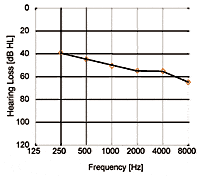
An estimated 1.4 million youth have hearing loss, but only 12% wear hearing devices, according to a national study recently released by the Better Hearing Institute (BHI), Washington. Untreated hearing loss among young people was shown to lead to social, emotional, behavioral, and learning difficulties, according to the study. Three out of four parents indicated their child experienced "minor" to "serious" problems due to their hearing loss.
The goals of the Council include:
- Helping to raise national awareness of the importance of hearing health care for children
- Encouraging parents to have their children’s hearing tested, and if necessary, treated
- Addressing issues regarding hearing loss and children from parents and reporters via interviews, speeches, and articles, and
- Assisting in the development of surveys or polls, such as a survey on the adequacy of school hearing-test programs nationwide.
"Based on our findings, we are concerned that a sizeable population of young people in America is being left behind because they do not fit existing paradigms of hearing disability," says Sergei Kochkin, PhD, executive director of the BHI. "The BHI is delighted to have this outstanding panel of pediatric audiology experts help us tackle the problem of hearing loss among many of our nation’s children."
A recent study conducted by the BHI entitled, "Are 1 Million Dependents in America with Hearing Loss Being Left Behind?"—which appeared in the September 2007 edition of HR—found the following:
- Historically, 50% of infants who failed an initial hearing screening were not brought in for their follow-up evaluation with a detailed hearing test.
- Only 12% of children under the age of 18 with hearing loss use hearing aids; yet an estimated 1.5 million youth (including adult dependents) under the age of 21 have hearing loss that may be improved with amplification.
- Three in ten parents (32%) cite embarrassment or other social stigma issues as a reason their child does not use a hearing aid, and many parents were advised inappropriately that their child could not be helped because they had sensorineural hearing loss.
- One in five parents cannot afford hearing aids for their children.
- There is a tendency to minimize the impact of mild or moderate hearing loss, and unilateral hearing loss (hearing loss in one ear) among children despite the known impact on language, academic, and emotional development.
- The incidence of hearing loss among children may be as high as five times greater than that measured subjectively by the BHI in national polls, because the child’s hearing loss may be outside of the awareness of the parent, pediatrician, or educator.
"Research by the Better Hearing Institute as well as esteemed researchers in the field of pediatric audiology clearly indicates that we need to do more to educate parents and pediatricians as well as state and federal politicians to do more to help children with hearing loss," says Dr Jackie Clark, BHI pediatric advisor and clinical assistant professor at the School of Behavioral & Brain Sciences at the University of Texas Callier Center, which specializes in the diagnosis, treatment, and care of children with hearing loss.




